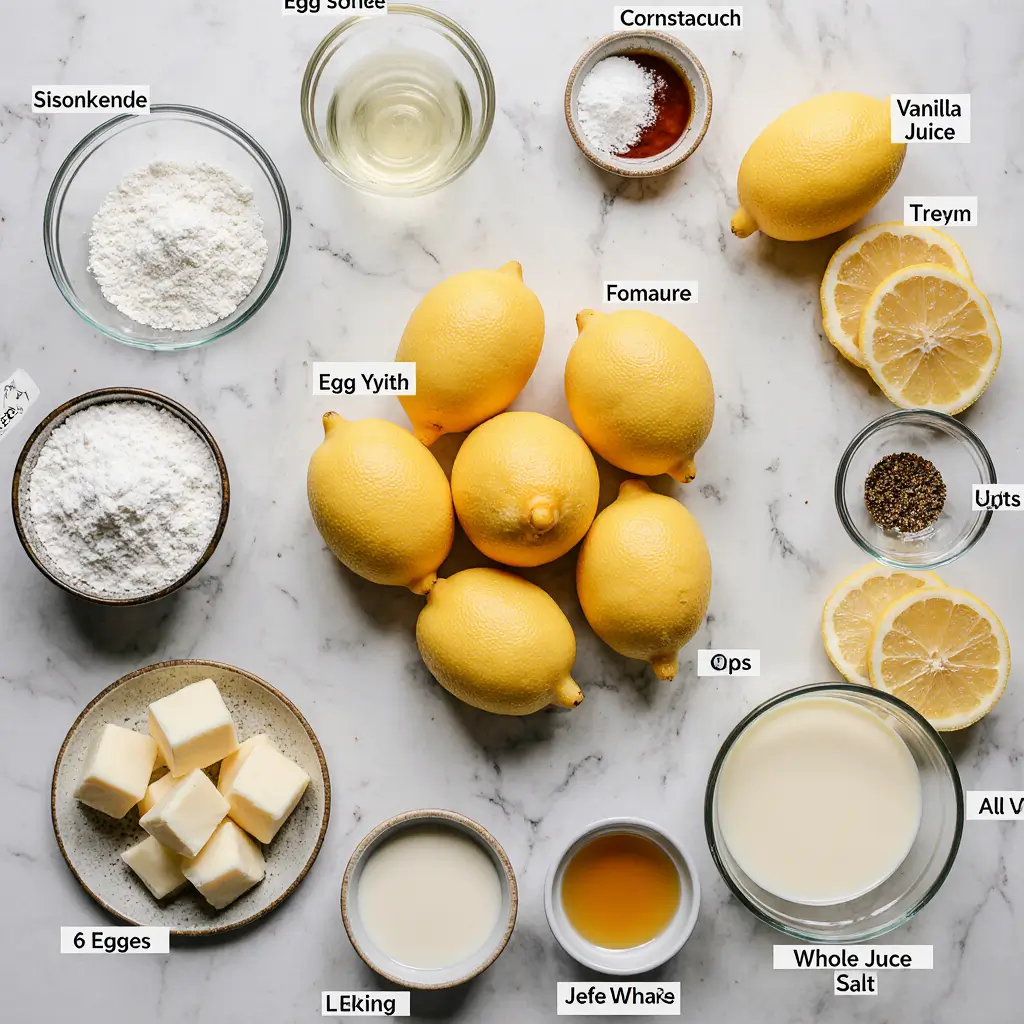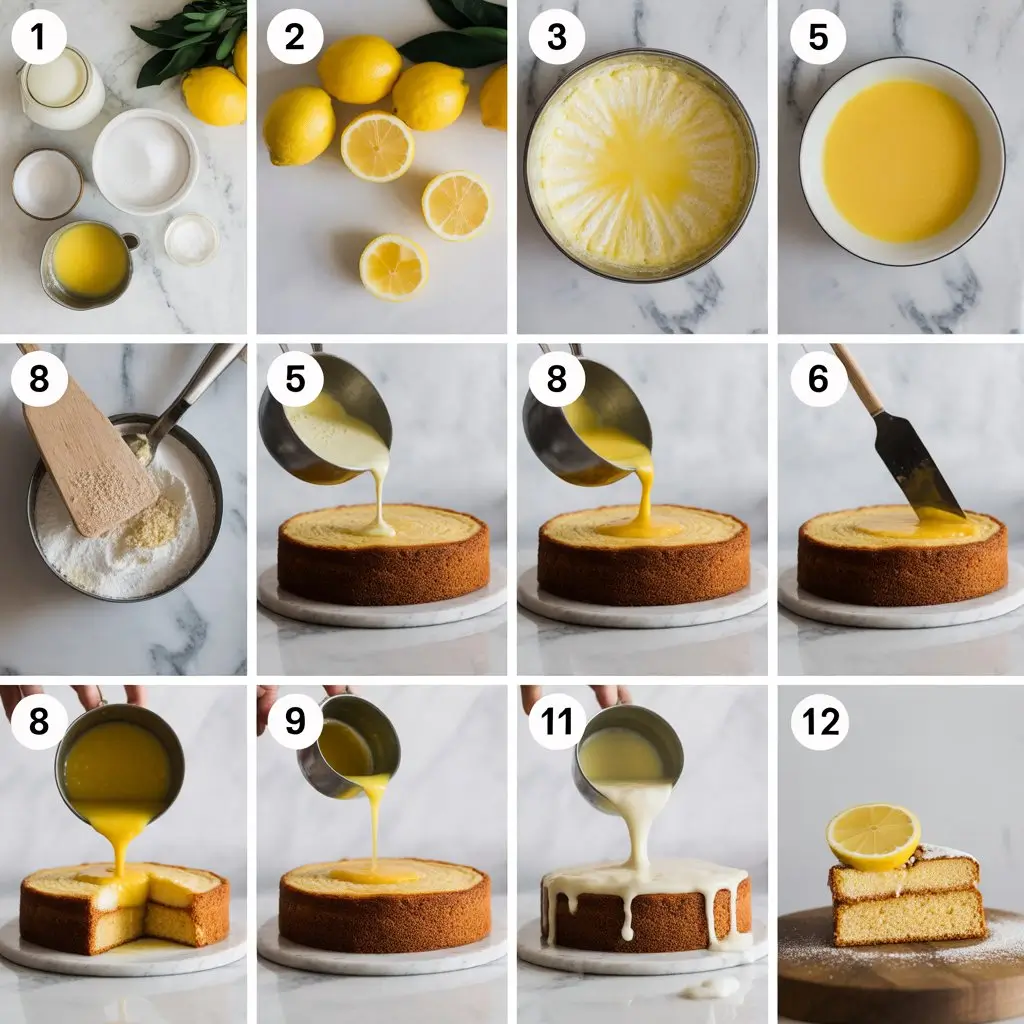Lemon Custard Cake Recipe

Have you ever experienced that moment when you take a bite of dessert and time seems to stand still? That’s exactly what happened to me three summers ago when my grandmother surprised our family gathering with her legendary lemon custard cake. The first spoonful revealed layers of velvety custard nestled between delicate sponge cake, infused with the bright, zesty essence of fresh lemons. It was pure magic on a plate, and I knew I had to master this recipe.
Today, I’m sharing everything you need to know about creating the perfect lemon custard cake – a dessert that combines the comforting richness of custard with the refreshing brightness of citrus. Whether you’re a seasoned baker or just starting your culinary journey, this comprehensive guide will help you create a show-stopping dessert that’s guaranteed to impress family and friends.
What Makes Lemon Custard Cake So Special?
The Perfect Balance of Flavors and Textures
Your lemon custard cake stands out from other desserts because of its unique combination of contrasting yet complementary elements. The tangy brightness of fresh lemon juice cuts through the rich, creamy custard, creating a dessert that’s both indulgent and refreshing. The soft, airy sponge cake provides the perfect textural contrast to the smooth custard filling, making every bite an exciting experience for your taste buds.*

Versatility for Every Occasion
One of the greatest advantages of mastering a lemon custard cake recipe is its incredible versatility. This elegant dessert works beautifully for:
- Birthday celebrations and special occasions
- Summer garden parties and barbecues
- Holiday gatherings and family reunions
Health Benefits of Lemon in Desserts
When you incorporate fresh lemons into your custard cake, you’re not just adding flavor – you’re also boosting the nutritional value. Lemons are packed with vitamin C, antioxidants, and natural enzymes that can aid digestion. While this lemon custard cake is certainly a treat, the citrus component adds a healthy twist to your indulgence.
Essential Ingredients for Perfect Lemon Custard Cake
Core Cake Components
Creating an exceptional lemon custard cake starts with selecting the right ingredients. Your success depends on using fresh, high-quality components that work together harmoniously.

| ngredient | Quantity | Purpose |
|---|
| All-purpose flour | 2 cups | Cake structure |
| Granulated sugar | 1 cup | Sweetness and texture |
| Butter (unsalted) | ½ cup | Moisture and richness |
| Eggs | 4 large | Binding and leavening |
| Baking powder | 2 tsp | Rise and lightness |
| Fresh lemon juice | ¼ cup | Citrus flavor |
| Lemon zest | 2 tbsp | Intense lemon aroma |
| Vanilla extract | 1 tsp | Flavor enhancement |
Custard Filling Essentials
The custard component of your lemon custard cake requires specific ingredients to achieve that perfect creamy consistency:
| Ingredient | Quantity | Purpose |
|---|---|---|
| Whole milk | 2 cups | Custard base |
| Heavy cream | 1 cup | Richness and texture |
| Egg yolks | 6 large | Thickening agent |
| Cornstarch | 3 tbsp | Stabilizer |
| Sugar | ¾ cup | Sweetness |
| Fresh lemon juice | ⅓ cup | Citrus flavor |
| Butter | 3 tbsp | Smoothness |
Premium Ingredient Substitutions
Understanding ingredient substitutions can help you create your lemon custard cake even when you don’t have every item on hand. Heavy cream can be replaced with whole milk for a lighter custard, though the texture will be less rich. If fresh lemons aren’t available, you can use bottled lemon juice, but reduce the quantity by about 25% as it tends to be more concentrated.
Step-by-Step Lemon Custard Cake Preparation
Preparing the Perfect Sponge Base
The foundation of your lemon custard cake lies in creating a light, airy sponge that can support the creamy custard filling without becoming soggy. Begin by preheating your oven to 350°F (175°C) and greasing a 9-inch round cake pan.
Start by creaming the butter and sugar until light and fluffy – this process should take about 4-5 minutes with an electric mixer. Gradually add the eggs one at a time, ensuring each is fully incorporated before adding the next. The key to a successful lemon custard cake is not to rush this process.
In a separate bowl, whisk together your dry ingredients: flour, baking powder, and a pinch of salt. Alternate adding the dry ingredients and milk to your butter mixture, beginning and ending with the flour mixture. Fold in the fresh lemon juice and zest gently to preserve the cake’s delicate structure.

Mastering the Custard Filling Technique
Creating silky smooth custard for your lemon custard cake requires patience and attention to temperature control. In a heavy-bottomed saucepan, combine the milk and cream over medium heat until it just begins to simmer. Meanwhile, whisk together egg yolks, sugar, and cornstarch in a separate bowl until the mixture becomes pale and thick.
The critical step in custard making is tempering – slowly pour about one-third of the hot milk mixture into the egg yolk mixture while whisking constantly. This prevents the eggs from scrambling and ensures a smooth custard. Return the mixture to the saucepan and cook over medium-low heat, stirring constantly with a wooden spoon until it coats the back of the spoon.
Remove from heat and immediately stir in the lemon juice and butter. The acidity from the lemon will help set the custard while adding that signature tangy flavor that makes this lemon custard cake so irresistible.
Assembly and Baking Techniques
Assembling your lemon custard cake requires a strategic approach to ensure even distribution of custard and proper baking. Once your sponge cake has cooled completely, carefully slice it horizontally into two even layers using a long serrated knife or cake wire.

Place the bottom layer back in your cake pan and pour the cooled custard over it, spreading evenly to the edges. Gently place the top cake layer over the custard, pressing lightly to ensure good contact. The custard should come slightly up the sides of the cake layers.
Advanced Tips for Lemon Custard Cake Success
Temperature Control and Timing
Achieving the perfect lemon custard cake requires mastering temperature control at every stage. Your custard should be completely cooled before assembly to prevent it from soaking into the cake layers. If you’re in a hurry, you can speed up the cooling process by placing the custard in a shallow dish and covering it with plastic wrap pressed directly onto the surface to prevent a skin from forming.
The final baking phase of your assembled lemon custard cake should be done at a lower temperature – around 325°F (163°C) – to gently set the custard without overcooking the cake layers. This typically takes 25-30 minutes, and you’ll know it’s ready when the center is just set and doesn’t jiggle when gently shaken.
Troubleshooting Common Issues
Even experienced bakers sometimes encounter challenges when making lemon custard cake. If your custard becomes lumpy, don’t panic – simply strain it through a fine-mesh sieve while it’s still warm to remove any cooked egg pieces. A lumpy custard can also be rescued by using an immersion blender to smooth it out.
If your cake layers are browning too quickly during the final baking phase, cover the top loosely with aluminum foil to prevent over-browning while allowing the custard to finish setting. Remember that the lemon custard cake will continue to set as it cools, so don’t over-bake it.
Professional Presentation Techniques
Transform your homemade lemon custard cake into a bakery-worthy dessert with these presentation tips. A light dusting of powdered sugar just before serving adds an elegant finish, while fresh lemon slices or candied lemon zest can provide beautiful garnishes that hint at the flavors within.
For special occasions, consider creating a lemon glaze using powdered sugar, fresh lemon juice, and a touch of cream. Drizzle this over your cooled lemon custard cake for an extra layer of citrus flavor and visual appeal.
Serving and Storage Guidelines
Optimal Serving Conditions
Your lemon custard cake is best served chilled, as this allows the custard to maintain its perfect consistency while highlighting the bright lemon flavors. Remove the cake from the refrigerator about 15 minutes before serving to allow it to come to the ideal temperature – cold enough to maintain structure but not so cold that the flavors are muted.
When cutting your lemon custard cake, use a sharp knife dipped in warm water and wiped clean between slices. This technique ensures clean cuts that showcase the beautiful layers of cake and custard. Each slice should reveal the distinct layers that make this dessert so visually appealing.
Storage and Freshness Tips
Proper storage is crucial for maintaining the quality of your lemon custard cake. Store the finished cake in the refrigerator, covered with plastic wrap or in an airtight container. The cake will maintain its best quality for up to 4 days, though the flavors actually improve after the first day as they have time to meld together.
If you need to prepare your lemon custard cake in advance, you can make the components separately and assemble them up to 24 hours before serving. This actually allows the flavors to develop more fully and can result in an even more delicious final product.

Freezing Options
While the assembled lemon custard cake doesn’t freeze particularly well due to the custard filling, you can freeze the sponge cake layers individually for up to 3 months. Wrap them tightly in plastic wrap and aluminum foil, then thaw completely before assembling with fresh custard. This can be a great time-saving technique for planned entertaining.
Creative Variations and Flavor Combinations
Seasonal Adaptations
While the classic lemon custard cake is perfect year-round, you can adapt this recipe to highlight seasonal ingredients. During summer, add fresh berries to the custard layer or create a mixed berry compote to serve alongside. The natural sweetness of berries complements the tart lemon flavor beautifully.
For autumn variations, consider incorporating a hint of cinnamon or nutmeg into your custard mixture. A light sprinkle of these warm spices can transform your lemon custard cake into a comforting fall dessert while maintaining its signature bright flavor profile.
International Flavor Inspirations
Draw inspiration from global dessert traditions to create unique variations of your lemon custard cake. Italian-inspired versions might include a touch of limoncello in the custard, while French-style preparations could incorporate vanilla bean paste for a more sophisticated flavor profile.
For a tropical twist, try adding coconut milk to your custard mixture and garnishing with toasted coconut flakes. This creates an interesting contrast with the lemon while maintaining the cake’s essential character.
Dietary Modifications
Modern dietary considerations don’t have to exclude you from enjoying lemon custard cake. For gluten-free versions, substitute the all-purpose flour with a quality gluten-free flour blend, ensuring it contains xanthan gum for proper structure.
Dairy-free adaptations can use coconut cream and plant-based milk alternatives, though the custard texture may be slightly different. The key is maintaining the proper ratios of thickening agents to achieve that signature creamy consistency.
Conclusion
Creating the perfect lemon custard cake is a rewarding journey that combines technical skill with creative expression. From selecting the freshest ingredients to mastering the delicate balance of flavors and textures, every step contributes to a dessert that’s truly special. The combination of tangy lemon, creamy custard, and tender cake creates a harmony of flavors that’s both comforting and sophisticated.
Remember that baking is as much about patience and practice as it is about following recipes. Each time you make this lemon custard cake, you’ll discover new nuances and develop your own personal touches that make it uniquely yours. The joy of sharing this beautiful dessert with family and friends makes every effort worthwhile.
Whether you’re celebrating a special occasion or simply want to treat yourself to something extraordinary, this lemon custard cake recipe will become a treasured addition to your baking repertoire. The combination of classic techniques and modern insights ensures that your results will be consistently delicious and impressive.
Frequently Asked Questions
How long does it take to make a lemon custard cake from start to finish?
Making a complete lemon custard cake typically takes about 3-4 hours from start to finish, including preparation, baking, and cooling time. The actual hands-on time is approximately 45 minutes to 1 hour, but you’ll need to allow for cooling periods between steps. The custard needs time to cool before assembly, and the finished lemon custard cake should chill for at least 2 hours before serving for the best texture and flavor development.
Can I make lemon custard cake ahead of time for a party?
Yes, lemon custard cake is actually an excellent make-ahead dessert that often tastes even better the next day. You can prepare the complete cake up to 2 days in advance and store it covered in the refrigerator. The flavors meld beautifully over time, and the custard sets to the perfect consistency. For best results, add any decorative garnishes just before serving to maintain their fresh appearance.
What’s the best way to prevent my lemon custard cake from becoming soggy?
To prevent sogginess in your lemon custard cake, ensure that both the cake layers and custard are completely cooled before assembly. The custard should be thick enough to hold its shape but not so thick that it won’t spread evenly. Additionally, avoid over-soaking the cake layers with any liquid, and serve the cake within 3-4 days of preparation. Using a properly baked sponge cake that’s not too dense will also help maintain the ideal texture throughout storage.
Ready to create your own show-stopping lemon custard cake? Start gathering your ingredients today and experience the joy of making this incredible dessert from scratch. Share your results and any creative variations you discover – your fellow bakers would love to hear about your lemon custard cake adventures!
Are You Try This Recipe ?
There are no reviews yet. Be the first one to write one.

